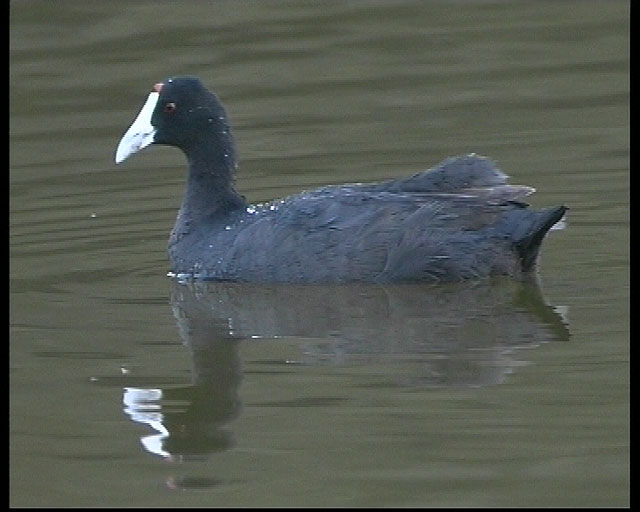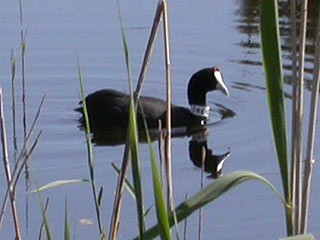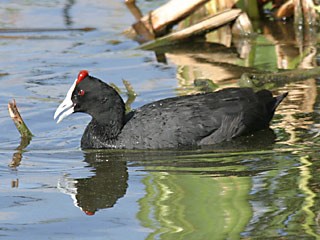
Red-knobbed Coot: Morocco, May At close range, separation would appear to be straightforward. The two red knobs above the broader frontal shield, blueish-grey bill, plus the distinctive jizz aid a rapid solution (video-grab: Dave Gosney).
Introduction and status
Although the Red-knobbed (or Crested) Coot is one of Europe's rarest breeding birds, it is, perhaps, not among the most glamorous. With a fragmented global distribution, the main population is located in eastern and southern Africa, and a much smaller isolated population is found in the western Mediterranean. The European population, at the northernmost extreme of the species' range, numbered 80 pairs in 2002, all of which were in Spain.
During the 20th century, the range in the western Mediterranean decreased significantly with a corresponding marked decline in the population. Fewer than 10,000 individuals were estimated in the mid-1990s. In Morocco there are an estimated 500-1,000 breeding pairs. Mid-winter counts of 2,000-3,000 were observed there in the 1980s but these had declined to 600-1,000 in the 1990s. Within this region, declines have been mainly due to habitat loss, whilst hunting has also contributed.

Red-knobbed Coot: Mallorca, July Birds from the re-introduction scheme were fitted with conspicuous PVC neck-collars (photo: James Smith).
The vulnerable Spanish population was recently supplemented through the release of captive-bred birds, plus reintroductions also took place on Mallorca, at S'Albufera, where 20 captive-bred individuals were released in 2004. Birds from the Spanish reintroduction scheme carry a white PVC collar with black letters. Some of the older-marked birds wore a black PVC collar with white codes. As a result of the reintroduction scheme, the species has been recorded well away from its usual breeding grounds, ranging to Galicia in the extreme northwest corner of the Iberian peninsula, to Catalonia in the northeast. Occasional reintroduced birds have been found inland but they have tended to spread along the Mediterranean region, particularly so in the regions of Andalusia and Valencia.
Where to see Red-knobbed Coot in Spain and Morocco
In Spain the stronghold is in the Doñana and surrounding areas, as well as the Valencia area. There is a very small population irregularly breeding in Catalonia in the Ebro Delta where there are currently around 5 birds. Red-knobbed Coot has been seen from time to time at Llobregat Delta, Barcelona and there is currently a bird at Ivars Lagoon, Lleida (the 1st record for this inland Catalonia province).
Key sites for Red-knobbed Coot in Spain:
- Espera lagoon complex (Cádiz)
- Doñana National Park (Huelva-Seville)
- Puerto Santa María lagoon complex (Cádiz)
- Chiclana lagoon complex (Cádiz)
- Medina lagoon (Cádiz)
- Ratosa lagoon (Málaga)
- Campillos lagoon complex (Málaga)
- Cantaritas (Seville)
Morocco easily hosts the largest, and most important, population of Red-knobbed Coot in the western Mediterranean. However, it is locally uncommon and rapidly declining. It breeds in Lower Loukkos marshes and at Sidi Bourhaba and is locally common on lakes in Middle Atlas. It has bred near Merja Zerga and other sites, some of which have since been drained. In winter the main concentrations are in the coastal wetlands, though some stay in the mountain lakes. The regional population is estimated to be in the order of 5,000 birds, though some huge gatherings have occurred, such as 3,000 at Marais Bas Loukkos in the midwinter census of 1991.
Key sites for Red-knobbed Coot in Morocco:
- Aguelmam Afenourir
- Marais Bas Loukkos
- Dayat Aaoua
- Sidi Bou Ghaba
- Aguelmam Sidi Ali
- Aguelmam Tifounassine
Many of the key sites for this species are described in detail, with clear maps, in the books Finding Birds in Southern Spain and Finding Birds in Northern Morocco by Dave Gosney (both available via our e-store).
Identification
Behaviourally, the Red-knobbed Coot tends to be less conspicuous than its familiar congener, the Coot, keeping more to cover, with less inclination to venture into open water. Structurally, and plumage-wise, the two species are very similar. Hence they can be difficult to separate at a distance, or outside the breeding season, though Red-knobbed Coot is slightly bulkier, with longer wings and neck. The actions of the two also differ; Red-knobbed appears as though it doesn't have the energy to keep its head and neck upright, almost as though an invisible puppeteer is controlling its movements!
 |
 |
| Red-knobbed Coot: South Africa, December The extent of feathering at the base of the bill and under the shield differs from Coot, being gently rounded making the shield appear convex (photo: Keith C C Mitchell). | Coot: Greater Manchester On Coot the pointed wedge under the shield differs markedly from Red-knobbed Coot (photo: Sue Tranter). |
Key identification features:
- Very similar to Coot, but with the slate tone often less obvious than that species.
- Breeding birds show two diagnostic red knobs above the broader frontal shield, but these are reduced following breeding and can be difficult to observe, especially at long range.
- The extent of the feathering at the base of the bill, and under the shield, differs from Coot, being gently rounded. This makes the shield appear convex, as opposed to the pointed wedge under the eye evident on Coot.
- Head-on, the frontal shield is squared-off and extends higher onto the crown than Coot.
- Jizz differs from Coot, with the rear of body raised, often showing a 'fluffy bum'; the neck bends from the centre when picking food, unlike Coot which bends the whole of the neck.
- In flight, Red-knobbed lacks the greyish-white border to the secondaries characteristic of Coot.
- At close range, the bill is white with a bluish-grey tip, unlike Coot, which has a pinkish cast. At distance the bill of Red-knobbed appears 'dirty', whereas Coot retains an element of 'cleanliness'.
- The bill looks slightly longer than on Coot and can appear to 'droop' noticeably at the tip.
- Legs greyish, as opposed to the greenish colouration of Coot, though this feature likely to be redundant under such close views!
- Voice differs from Coot, being lower-pitched and softer. They often give a short, monosyllabic call, 'herp' which is more nasal and plaintive than the calls of Coot.
- Juveniles are much darker than Coot of the same age, with the whitish colouration present only on the throat.
- Vagrant adult American Coot also shows almost red marks on bare parts of head but its white sides to the undertail-coverts, blackish band across the bill, and profile, should allow speedy separation.
 |
 |
| Red-knobbed Coot: Morocco, May Red-knobbed Coot is slightly bulkier, with longer wings and neck; the rear of body appears raised and 'fluffy'. The head and neck actions appear as though they are controlled by a puppeteer, recalling a 'nodding dog'! (video-grab: Dave Gosney). | Coot: Morocco, May Shape and posture can be used as a rough guide to identification, with different jizz apparent on Coot; Red-knobbed Coot can sometimes look very Coot-like and further features should be sought to confirm the identification (video-grab: Dave Gosney). |
 |
 |
| Red-knobbed Coot: Morocco, May The bill has a bluish-grey tip, making the bill look 'dirty' at range (video-grab: Dave Gosney). | Coot: Norfolk, February On Coot the bill has a pinkish cast, and always looks clean, even at a distance (photo: Mark Braun). |
These differences, and indeed those of any confusion species can be fully appreciated through comparison of both side-by-side. Extensive footage of Red-knobbed Coot can be seen on BWPi 2006. This is a supplement to BWPi which adds new video clips, new sound recordings, updated population details and more species texts from BWP Update, in such a way that the new material appears within the menus of the current BWPi. For further details go to www.birdguides.com/bwpi.
References
Birdlife International. 2004. Birds in Europe: Population estimates, trends and conservation status. Cambridge, UK: Birdlife International. (Birdlife Conservation Series No. 12).
Cramp and Simmons. 2004 Birds of the Western Palearctic interactive. Published by BirdGuides, Sheffield.
Rose P.M. and Scott D.A. 1997. Waterfowl Population Estimates. Second Ed. Wetlands International Publication 44. Wetlands International, Wageningen, the Netherlands.
Thevenot, M., Vernon, R., Bergier, P. 2003. The Birds of Morocco. An annotated checklist BOU, Tring
Convention on the conservation of European wildlife and natural habitiats: Action plan for the Crested Coot (Fulica cristata). Available at: http://www.coe.int/T/E/Cultural_Co-operation/Environment/Nature_and_biological_diversity/Nature_protection/sc22_inf07e.pdfnet. Accessed April 2, 2006.
TAIB Project S'Albufera: A Mediterranean model for the study of biodiversity and environmental change. The Albufera International Biodiversity Group Annual Report 2004. Edited by Nick Riddiford. Available at: http://www.fsd.nl/TAIB/downloads/taibrep2004.pdf. Accessed April 2, 2006.
Acknowledgements
Many thanks to Ricard Gutiérrez of Rare Birds in Spain.



